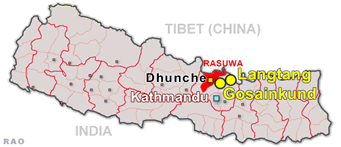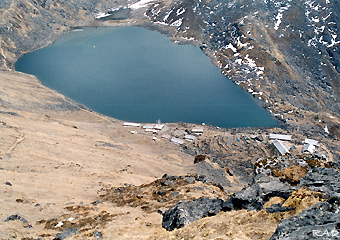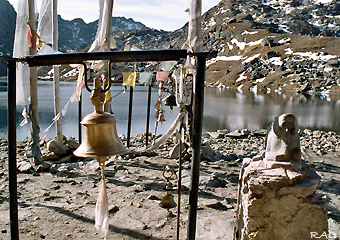 |
Nepal Tourism |
|
|
 |
|
On
the way to Langtang - Gosainkunda
|

|
 |
Gosainkunda,
at an elevation of about 4,450m above sea level is one of the most revered
pilgrimage and tourist sites in the country owing to its great religious
importance and amazing natural beauty. People in their thousands throng
to Gosainkunda every year on two occasions: Dashahara or Jeshtha Shukla
Dashamee and Janai
Poornima or Rishi Panchamee. |
The
first event is the tenth day (dashamee) of the bright (shukla) fortnight
(paksha) in the month of Jeshtha that falls in June. The belief that taking
a bath in a holy river or pond and offering pooja (worship) on this day
relieves a person from certain ten sins, is also popularly known as Dashahara."
Janai
Poornima is named as such because it is on this full-moon, falling in the
last part of the month of Shraavan (mid-August), that adult males of the janai (sacred thread) wearing classes (Brahmin and Chhetris) replace their
janai with a fresh one with blessings from a priest and hand over dakshina
(money) to him.
Also
performed on the same day in the same way is Raksha Bandhan, or tying the
cotton thread around the wrist for protection. The day is also recognised
as Rishi Tarpanee as people show their respect (tarpan) to rishis
(sages) for their holy deeds. Devotees fast in the early part of the day
and eat a vegetarian meal later.
 |
 |
| Gosainkund
(4,381 m) |
Gosainkund
(4,381 m) |
Gosainkunda remains their first choice
of destination for such events. For persons unable to reach Gosainkunda,
Kumbheshwar in the middle of Lalitpur is the alternative. Experts say the
proposed highway will not only ease pressure on the 125-km Kodari Highway - which was also constructed with the Chinese assistance in the 1960s -
but also contribute towards boosting the age-old trans-Himalayan trade
subsisting between the two Asian neighbours. The road will be Nepal's shortest
roadlink with China when completed. It will help boost Nepal's economy
in that Chinese goods will have easier access to Nepal's markets, and that
we will have shorter via-Tibet-route to supply foodgrains to our inaccessible
hills districts of the western and mid-western regions.
The Syabrubensi - Rasuwagadi Highway is also expected to cut short the distance
between Nepal and Lhasa, the capital of Tibetan Autonomous Region of China.
Reportedly, Gosainkunda draws a greater number of visitors in Janai Poornima than in Dashahara. Hindu pilgrims largely from Nepal and substantially
from India make it to the former festival and those visiting in the Dashahara
are from other neighbouring countries. During this year's Janai Poornima
an estimated total of about 8,000 people visited Gosainkunda.
Quite
a few of such events had gone by before I decided to set out for the pilgrimage
to Gosainkunda for this year's Janai Poornima. I nearly missed the opportunity
because of the bus operators manipulating the seat reservation. But luckily
I managed to get my seat back. After leaving from Kathmandu at 8 in the
morning, we reached Dhunche at around 5 p.m. And the following evening
at about 6 p.m our pilgrimage started from Dhunche. I had started my journey
alone but naturally came in contact with many fellow pilgrims on the way.
However, going in a pre-arranged suitable group is more advisable.
Soon
afterwards, the process of seperation among individuals and groups based
on the ability to walk began to show itself. Some managed to reach Gosainkunda by evening, some halted at Laureebina, and many still remained far behind.
The trail was fairly wide but the steep course was unexpectedly lengthy
and excessively tiring. Unable to continue the walk, a few people gave
up the final upward journey and turned back, some fell sick but recovered
and completed the trip. There was also a rumour that one young man died
of altitude sickness. Apart from such few unfortunate and tragic incidents,
the overall journey did not seem too severe. Taking various sorts of precautions
and care while going uphill was, however, extremely necessary. Surprisingly,
the comfortable composure and pace of some elderly people (a few of them
close to their eighties) seemed to instill strength and spirit into many.
The
problems caused by the notorious leeches were almost fully nullified most
probably due to the dilution caused by the excessively large number of
their preys, the travellers. But clearly, some effective measures are urgently
needed to rectify the largely unfair dealings of some of the lodge owners
and the reckless outdoor defecation.
Overall,
a pilgrimage to Gosainkunda is an enchanting, enthralling and enduring
experience with several important facets. For a Hindu devotee, taking a
dip in the water of Gosainkunda (kunda meaning lake) and performing a religious
rite there mean both salvation and virtue. The scenic splendour, the geo-morphological,
biological and climatic diversities and the social and anthropological
dimensions also appeal strongly to the interests and satisfaction of a
variety of other non religious visitors. After all, the kund and its surroundings
were, according to legend, created by Lord Shiva himself in order to eventually
soothe out the burning sensation caused by the poison that stuck in his
throat when he tried to swallow it to save all creatures.
Gosainkunda's
source is the Trishuldhaaraa, which is believed to have emerged when Lord
Shiva struck his trishul into the huge boulder lying a little above the
kunda so as to make the entrapped snow-melt water flow out. Being fed with
this water the Trishuli river has also derived its name thus. Although
the number of pools around the Gosainkunda area said to be 108 in total,
Sooryakunda, Saraswateekunda and Bhairavkunda are the prominent ones besides
Gosainkunda.
Report:
2001
| Photo Galleries |
 |
 |
|
Nepal |
|




